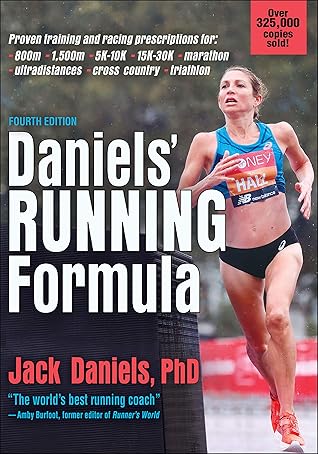More on this book
Community
Kindle Notes & Highlights
No one has all the answers as to how best to train, and there is no single system that works best for everyone.
You should always be able to answer this very simple question: “What is the purpose of this workout?”
A good approach to avoid overtraining is to always stick with the same amount and intensity of training for about four weeks before demanding or taking on more.
Every runner has specific individual abilities.
A runner’s focus must stay positive.
Expect ups and downs; some days are better than others.
Be flexible in training to allow for the unexpected.
Set intermediate goals.
Concentrate on the task at hand.
Runners need to learn to focus on what they are doing and not spend too much time worrying about others.
Most mistakes in races are made early in the race.
Training should be rewarding.
Eat and sleep well.
Don’t train when sick or injured.
Chronic health issues should be checked by a professional.
A good run or race is never a fluke.
From a runner’s standpoint, consistency in training is the single most important thing that leads to success.
There are as many individual pathways to success as there are individuals,
Eat well, rest often, and maintain a good state of hydration.
Principle 1: The Body Reacts to Stress
Your body does a very good job of adjusting to the stresses placed on
Principle 2: Specificity
The parts of the body being stressed become stronger and better prepared to deal with any future stress, as long as the body is in a state of good health.
Principle 3: Overstress
If you overstress some body parts, they may not get tougher; in fact, they may get
weaker or break down completely.
It is during the recovery, or rest time, between bouts of stress that the strengthening takes place.
Rest and recovery are a vital part of a training program, not an attempt to avoid training.
sometimes doing a less stressful workout will produce more benefits than will a harder session.
whenever you are not sure which of two training sessions to take on at any particular time, select the less stressful of the two.
Principle 4: Training Response
It is not a good idea to change more than one of the training variables.
Principle 5: Personal Limits
Something that should definitely be avoided is overtraining,
Training intensities should be determined by current fitness, which is best measured by race performances.
Principle 6: Diminishing Return
the fitter you become, the less benefit you get from training harder.
Principle 7: Accelerating Setbacks
Principle 8: Maintenance
it is easier to maintain a level of fitness than it was to achieve that fitness.
the stresses imposed on different parts of the body can help maintain some conditioning
there is no one specific route to success as a runner.
You must always be open to trying different types of training and to arranging training in different orders of importance throughout a season,
but at all times you should be able to answer the question “What is the purpose of this workout?”
the muscular discomfort associated with a hard session is realized more about 48 hours after the stress than it is 24 hours afterward.
is a mistake to try to make each week of training, or each specific workout, better than the previous week or the last time you did that specific workout.
Training is not always fun, but it should be rewarding, so don’t overdo it.
When not running very hard, you may breathe in for three steps and breathe out for three steps, and you may stay with this rate even when you feel the need to breathe harder by just increasing the size of each breath.
Most accomplished runners breathe with a 2-2 rhythm, especially when running fairly hard, because it is comfortable and allows a sizable amount of air to be breathed in and out of the lungs.
better to use that good 2-2 rhythm even in easy


